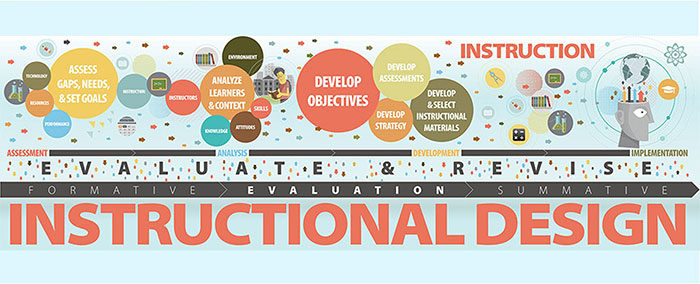Having been in the field for some years, experience dictates that strong communication skills are paramount for success.
Therefore, as an Instructional designer, one must always acknowledge that the audience is more important than the topic. When a project seems too complex, focusing on creating a sense of clarity goes a long way.
This often starts by connecting with the learners on an emotional level, understand how people learn and also, have the ability to imagine oneself as being a part of the crowd.
The main goal of instructional designers is to communicate effectively with the audience, both verbally and visually. They should also have a commitment and passion for learning to be able to design a course on any particular subject based on the expected outcomes, main budget and time. One should know how to create assessment methods designed to help students in their development.
Academic writing in many cases is considered an important aspect of education. Instructional designers can now have access to a professional writing service so that the teaching material is perfect containing any unforeseen last minute modifications. They may provide relevant materials or submit a draft with the specific with detailed information about the topic of study.
Let’s see how effective communication will help an Instructional designer socialize and forge meaningful connections with their target audience.
Top Secrets to Effective Communication as an Instructional designer

One of the most valuable skills in life that one could ever learn, if you plan on being a successful Instructional Designer, is how to communicate effectively with other people. This will surely help out in all aspects of life, both personal and professional, making it much easier to be understood and listened to. The following tips are tailored to assist an Instructional designer to get their message across as intended, without it losing its meaning:
- Learn to listen – in order to answer correctly and react properly, Instructional designers should learn to be attentive. They should then take into account all the details of what is being described. This will can only be achieved by being fully submerged within the topic and conversation.
- Use visual aids – these visuals will provide the learners with a clear and robust understanding of the key factors, steps, and the ideas.
- Engage the learners in the discussion – Get to know the audience first. Some will be active while others inactive. Ensure to interact with the learners throughout the discussion encouraging them to ask questions and give suggestions. Getting people involved is half the battle.
- Brief emphasis on key points – it is likely that most of the audience will fail to absorb as much content as you expect, especially when sharing new ideas. Reiterate the key points with clear explanations.
- Apply the Purpose-Importance-Preview (PIP) approach – during introductions, first state the presentations main purpose, goals, and objectives. Then share its benefits by reviewing the presentation implications and the possible outcomes. In the end, give a brief summary of the specifics that will then be discussed.
Effective communication is crucial when designing any course’s curriculum and activities. Thus, the instructional designer’s role is to ensure that all communication with the parties involved is well-planned and does not end up confusing everyone instead.

It is important to find the perfect balance when delivering the information as too much at a time will become a burden while too little could bore the audience. Engaging the learner at their own pace is essential to having an effective course, as well as using a variety of item types, images, and other delivery methods.
All these elements put together in a interactive way keep them interested in the task at hand. Instructional designers need to ensure learners are excited to learn the content and not just memorize the material only to forget it in a weeks time.
Skills that every Instructional Designer should have
- Problem-solving – instructional designers invest most of their time into fixing problems. They then search for the best ways to meet the learner’s goals and objectives using any available means.
- Knowledgeable project manager – instructional designers should be able to develop the right instructional strategy with case studies, evaluations and pre-class activities. Therefore, it’s of much importance for an instructional designer to have good project management skills.
- Have a background in education – clear learning objectives enable the instructional designer to be able to teach the courses in question at the highest level.
- Ability to conduct thorough research – they should, at all times, ensure to be up to date with new technology and educational concepts such as educational theories and standards of development. Also should have the ability to synthesize information from various sources.
- Imaginative, creative, and innovative – they should strive to generate new ideas, especially when trying to create informative and amusing eLearning courses. This can be achieved by creating informative content that can be applied in the real world using texts, audio, and video scripts.
Every job requires individuals to have certain characteristics which will determine how they interact and communicate with others. Have you ever wondered how effective communication makes a good instructional designer?
Well, let me show you the characteristics that help to improve instructional designer communication effectively helping the learners accelerate their job performances. Below are the examples of the best characteristics of an instructional designer:
- Have a passion for learning – an instructional designer should have a passion to know a lot of different things about different topics that help in designing instructions for learning.
- Strong analytical skills – it’s a requirement for instructional designers to learn how to collect detailed information in various forms, analyze and try to visualize content from different points of view. One of the greatest ability is to differentiate need-to-know from nice-to-know content.
- Be flexible – this allows one to put themselves in the learner’s shoes. This helps in understanding their needs, goals and individual learning styles.
Using the tips above will help you make the material stand out, thus increasing the odds of getting hired for a project.
It is important that you learn to communicate effectively as that is the cornerstone to develop the previously mentioned skills. Remember to focus on your audience, read their body languages and consider their response.
The post The secrets to communicating effectively as an Instructional designer appeared first on Design your way.
Source: https://ift.tt/2NyNyVr

No comments:
Post a Comment